Late in the Summer of 2003, a business trip took Randy Mitchell
back to Germany where he had the chance to visit what is now
designated as the 64th Replacement Depot at Rhine Main. Looking
just a bit forlorn, in need of fresh paint and some preventive
maintenance, he found the cannon and tank that once stood at
Daley. For those troopers who may have sons or daughters pass
through that area ready for their own European adventures, tell
them to take a second to pause by the display vehicles. They
silently have a lot of stories to tell. *Follow-up: Rhine Main AFB was returned to German control in 2005.
Soldiers reporting for assignment in Germany now go through
Ramstein AFB
| |
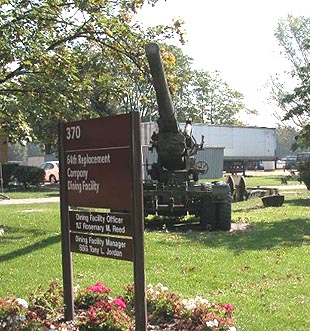 |
|
| |
155mm at Rhine Main.
--Randy Mitchell |
|
Thanks to Terry Dougherty and LTC Michael
Bigelow at the Center for Military History for their help in
telling this story.
Daley Barracks
Display Equipment Update
So things have a
habit of getting just a bit lost and then turning up, car keys,
dog leash, mortgage payments. It all works out in the end but
who ever heard of losing an Army heritage display tank? Well …
the lost has been found, the tank is under positive control and
the background story certainly has a few twists.
M4A1 ( 76 ) Sherman Tank HVSS - A Monumental Tank
When last seen at Daley Barracks, the
Sherman tank that had sat for decades in front of Squadron
Headquarters was being pulled up onto a heavy flat bed trailer.
With the installation closed, the light bulbs would remain in
the buildings but virtually all other Army property was on the
way to new homes and that included the display equipment.
| |
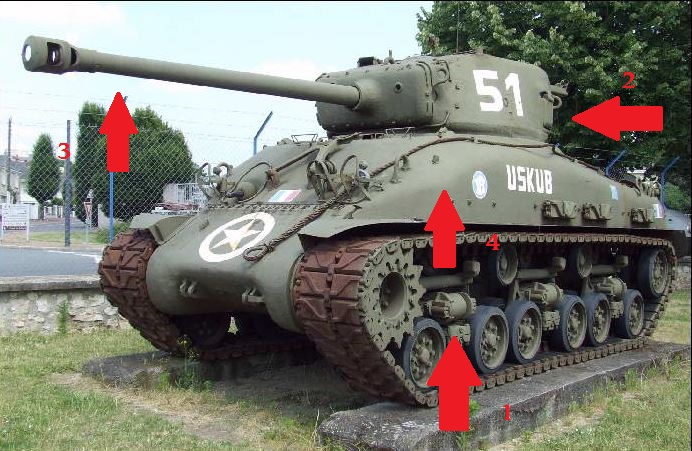 |
|
 |
|
| |
An example of an M4A1 (76 ) HVSS on display in France with key
recognition features marked:
1 - HVSS suspension system
2 - smaller turret
3 - 76mm cannon with muzzle break
4 - rounded over smooth cast hull |
|
Same model, this one is on display at the Patton Museum in
California.
|
|
Eventually, with
the great help of the Army’s Center for Military History, we
learned that the tank and companion display piece, the 155mm
cannon, were as of the early 2000s, displayed at the 64th
Replacement Depot at Rhine Main Airport. Randy Mitchell
photographed it in 2003 sporting generic OD green paint. Within
a year or two, this installation also closed, the site returned
to German hands and the equipment was once again, gone -
somewhere and so - some weeks back, we started a new search.
One would imagine
that the control of physical inventory of heritage items would
be as simple as a few key stokes, a spread sheet and then the
answer, but this was not the case, particularly for items held
in Germany. CMH referred our questions to the Office of the
USAREUR Historian who promised to help while we plunged into the
Internet looking for clues and hunting for a story.
| |
 |
|
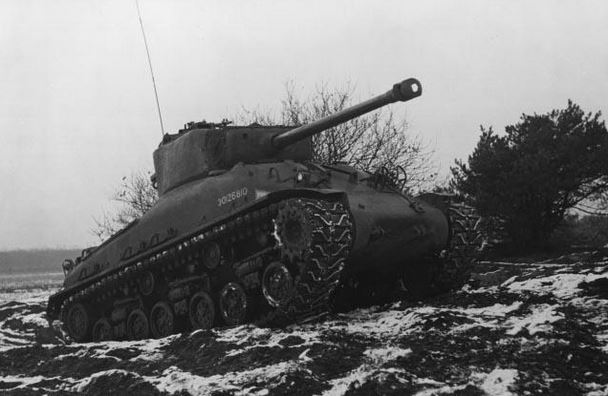 |
|
| |
Period image of an M4A1 in use by the Belgium Army in the 1950s. |
|
Second image of tank in use with Belgium Army. |
|
Well … it was big
and green and it had tracks …
The Daley
Barracks display tank was a Sherman, cast hull, model M4A1 with
a 76 mm cannon and Horizontal Volute Suspension System ( HVSS
), one of 1255 such units manufactured during WWII by the
Pressed Steel Car Corporation factory located in the far
southeastern Chicago neighborhood of Hegewisch. This area was
one of America’s heavy industry hubs taking advantage of rail
and Great Lakes water transportation, the ready availability of
processed steel and a willing work force to man assembly lines.
Pressed Steel was a major manufacturer of rail cars and similar
components so the transition to defense contracts was easy and
during the war, beyond certain models of M4 tanks, they were
either the lead manufacturer or key component provider for
thousands of other types of tanks and self propelled howitzers.
The local population was primarily first generation Greek and
Polish families and during the war, along with the middle aged
men, the wives, mothers and sisters of the servicemen committed
to the fight steadily worked the assembly lines.
| |
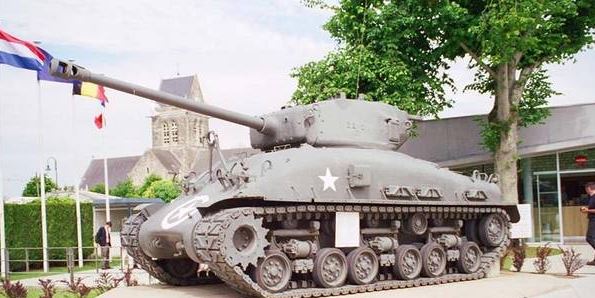 |
|
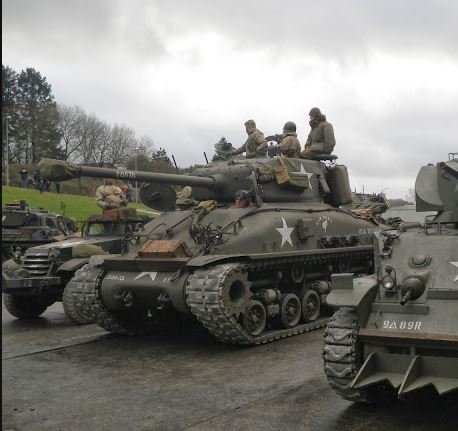 |
|
| |
On display in France. |
|
This one is an operational model used in parades in France. |
|
The M4A1 ( 76 )
HVSS was one of many variations of the Sherman tank produced
during the war and is generally included in a group of Shermans
known as the “ second generation “ that tired to incorporate
improvements based on early lessons learned in the war. The
production run for this particular model began in 1944 with
first copies arriving in England prior to the invasion and a
portion retained stateside for training.
Among key
recognition features, the tank had a rounded off upper hull cast
in a single piece and longer barrel 76mm cannon differing from
the short barrel 75mm cannon of earlier Shermans. Tanks
assembled starting in January 1945 also included a muzzle brake
at barrel end. Other improvements include wider tracks and an
accompanying new suspension with springs configured in what
engineers called a horizontal volute suspension system.
| |
Click on the thumbnail to view the
full-sized picture |
|
| |
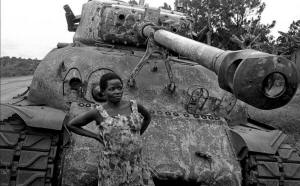 |
|
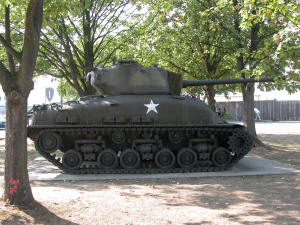 |
|
| |
And one from a small group that made it to Uganda via Israel.
|
|
Here is a sequence taken by Randy Mitchell of the M4A1, formerly
located at Daley and then moved to Rhine Main. You can see the
mismatched paint on the turret where the Blackhorse has been painted
over. |
|
As tanks go - it
was as adequate as any Sherman produced in the mid war period
but it was hardly a match for the German Panthers or Tigers and
from top generals down through the ranks - no one was
particularly impressed. As deliveries arrived in England, few
if any American battalions actually were issued this particular
tank. Rather, the fleet was held in depot stocks with some
then dispersed to British, Free French and Polish units under
the Mutual Defense Assistance Program.
Whether the Daley
Barracks tank was ever issued to American forces is impossible
to determine. What is clear is that when evidence begins to
turn up, this particular tank was in French hands, either given
to them in the last months of the war or, more probably,
dispersed in the immediate post war period when nearly the
entire fleet of M4A1 ( 76 ) HVSS was disposed of through MDAP or
its post war equivalent. Although no one looking at the Daley
tank during its many paint schemes would have noticed, on the
hull was an added marking plate indicating that at some point it
had gone through a French depot rebuild program. Sacrebleu! …
Or more correctly - Sacredieu!
| |
Click on the thumbnail to view the
full-sized picture |
|
| |
 |
|
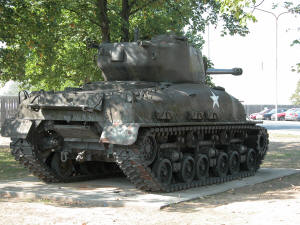 |
|
| |
Notice the bent over foot step at the mid line of the lower hull,
something added by the French during deport rebuild. |
|
¾ view from the rear, note that the Fenders are intact. |
|
One fact is
tellingly clear, of the thousands of photographs of various
models of Sherman tanks taken in combat during the war, there
appear to be zero images of the M4A1 ( 76 ) HVSS in a combat
setting. It was not a terrible tank, rather, it was late in
getting to the field and other models produced at the same time
by other manufactures were simply somewhat better and this
begins to lead us towards the tank seen at Daley Barracks and
explains why that particular model turns up fairly often in
European war memorials. Few if any examples were destroyed
during the war. The fleet, given away then rattled around in
many armies in the post war period and after some years, they
were retired at about the time that Western Europe had recovered
fully from the war and had begun to build commemorative
monuments. What better tank to haul up on to a concrete
pedestal, set up a flag pole and call it a day?
| |
Click on the thumbnail to view the
full-sized picture |
|
| |
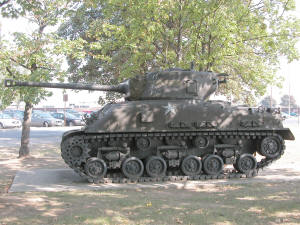 |
|
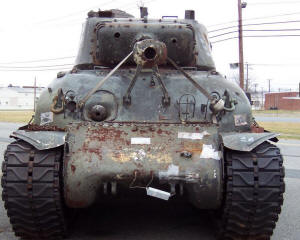 |
|
| |
Seen on the turret side, the partial remains of the crew names that
once were a part of the Daley Barracks paint pattern. |
|
Neil Baumgardners great set capturing the tank at APG prior to
refurbishment. Note the front step. |
|
How this
particular tank came to Daley Barracks is a matter or pure
speculation. Perhaps when first released from US control, the
gaining nation was obligated to make an effort to return the
tank once it was considered obsolete. Perhaps it was headed down
range as a target and it was salvaged. In looking at images of
various display vehicles found on American barracks, something
makes me think that many may have come from French sources. “
Hello Ami’s you can take this back now.”
| |
Click on the thumbnail to view the
full-sized picture |
|
| |
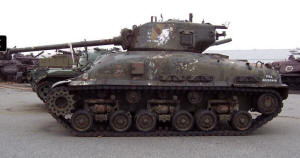 |
|
 |
|
| |
Seen in profile with much of the top layers of paint removed, on the
turret, both the outline of 14th ACR crest and the remains of the
crew list from 2/11 ACR period. |
|
Seen from the rear, the fenders did not fair well during the move
but the left side reveals the V 2/11 ACR marking and just above on
the hull, remains of French Army markings. |
|
The story now
goes fast forward to the mid 2000s and American tank expert Neil
Baumgardner who keeps track, pun fully intended, of display and
rare wrecks of tanks all over the world. He came across an
interesting project coming to life at the equipment shops of
Aberdeen Proving Ground. An M4A1 ( 76 ) HVSS had gone through a
lengthy pressure wash session and with layers of old paint
scoured away, amazingly the complete back story of the tank was
revealed.
Noted first are
recognizable portions of French era symbols that can be seen on
the hull, then on the turret, the remains of the 14th ACR
insignia with red highlights on the edges where the 11th ACR
Blackhorse had been over painted; the dented mud flaps even
noted 2/11 ACR. The lost was found and oh happy day … and then
the tank was towed into the shops for refurbishment, double
doors closed and men in coveralls, welding masks and painting
hoods went to work.
Neil’s final
photos show the complete cosmetic restoration of the Daley tank
as it sits in the Maryland sun in a row of display tanks at
Aberdeen Proving Ground. The sheet metal has been fixed, the
French added front hull step is now straightened. There is no
marker or display tablet informing the viewer as to the model or
history of this particular tank. The display is as generic as
possible and how odd that a tank so long associated with the
2/11 ACR at Daley may never have had an American crew and
echoing through the hull and across the years, “ Allons! “ the
Regimental motto - Let’s Go! - the same word a French tank
commander would say to his driver, a shorthand for “ move out “.
| |
Click on the thumbnail to view the
full-sized picture |
|
| |
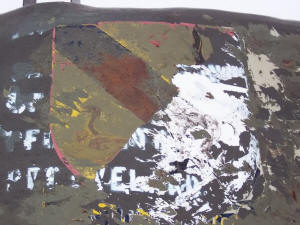 |
|
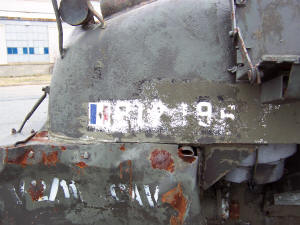 |
|
| |
Turret close up of 14th ACR crest, red paint outline of 11thACR
crest and partial remains of crew list. |
|
Close up of 2/11 ACR bumper marking and French Army marking. |
|
So it was fate,
circumstance or just luck that this one survived but short of
flying to Bad Kissingen for a stroll down the tank trails of
memory lane, if you wish to reach out and touch the past, an
artifact of Daley Barracks has come home to you. When visiting
APG, please insure you have all your automotive paperwork in
order to include proof of insurance. The vast majority of what
once was a grand display of American and foreign tanks and
artillery has moved away but there still have a few ghosts, a
line of tanks in a field, a Sherman with a story and a tank with
a tale. Allons!
| |
Click on the thumbnail to view the
full-sized picture |
|
| |
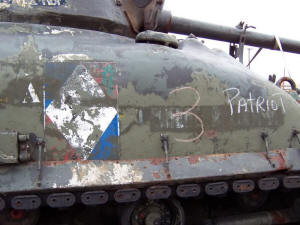 |
|
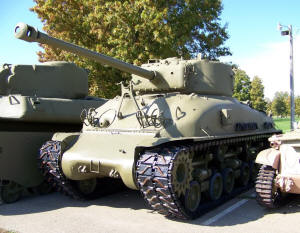 |
|
| |
A different French Army marking found deep in the paint layers. |
|
Neil’s final image after the refurbishment was completed. The Daley
Barracks M4A1 ( 76 ) HVSS on display at APG. |
|
Notes:
Beyond being a
pest at CMH and Office of the USAREUR Historian, I have done
very little original research in telling this story. Great
credit must be given to Neil Baumgardner for both his written
work and images as well as George R. Bradford and his contacts,
associates and friends at Armored Fighting Vehicle News.
And finally thanks to Army Historian
Molly Bompane … and I promise I won’t come calling again … but
about that
M3 ½ track
that used to be at Daley and then it moved to Hohenfels … ya ‘
see - it too was manufactured in Hegewisch but not at Pressed
Steel but rather at the Ford truck plant, I can drive you around
if you want to see … and then the French somehow got it and …
then it showed up at Daley Barracks and they got it running …
To learn more
about the Sherman tank and all of the various models, production
history and key recognition features, go here.
To see another
series of images of a M4A1 ( 76 ) HVSS on display at Diekirch,
Luxemburg
To see the
complete Neil Baumgardner photo set of the Daley Barracks
Sherman tank as it went through refurbishment
To see a good but
not complete inventory of M4A1 (76) as war memorial displays
To learn more
about Pressed Steel and war era production in Hegewisch
The Pressed Steel
Production Plant in Hegewisch has been razed and now, fully
paved over, is a rail trans - shipment point for new and late
model used cars.
July 2014